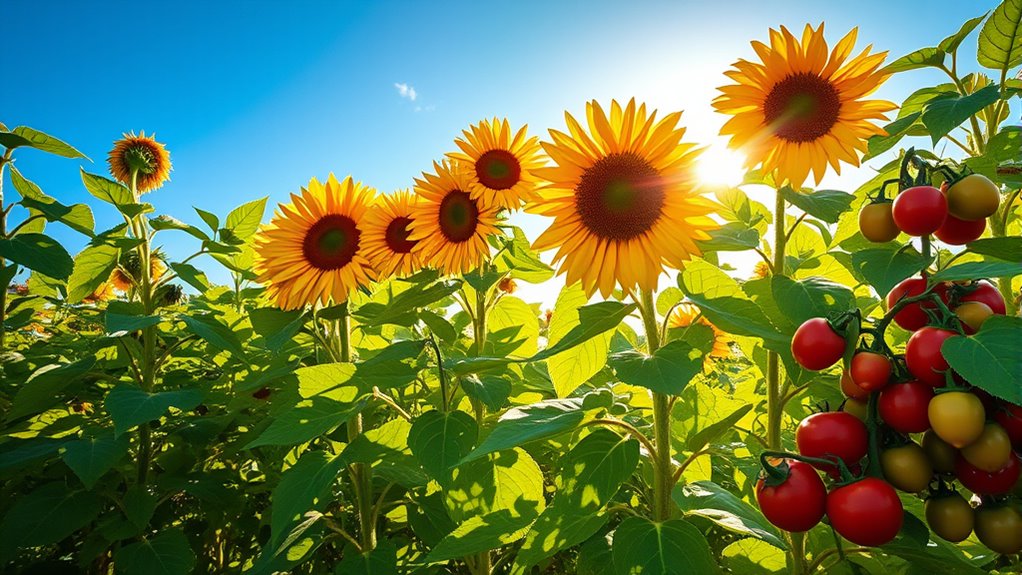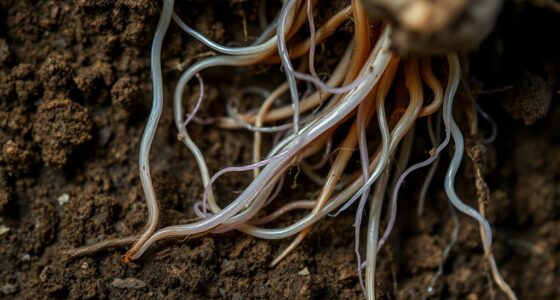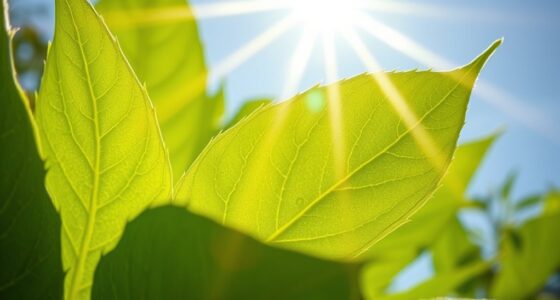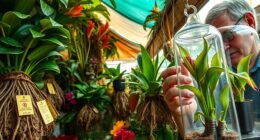During the summer solstice, you experience the longest day of the year, when peak sunlight warms the Earth’s surface. This intense solar radiation boosts plant growth by increasing photosynthesis, encouraging flowering, and supporting reproductive processes. Longer daylight hours also influence microclimates, leading to lush, vibrant plants and faster development. If you want to understand how this seasonal sun influence shapes ecosystems and plant cycles, keep exploring these fascinating effects.
Key Takeaways
- The solstice marks the longest day, providing maximum sunlight for plants to photosynthesize effectively.
- Increased daylight triggers flowering and flowering-related processes in many plant species.
- Peak solar radiation enhances photosynthesis, boosting plant growth, fruiting, and seed production.
- Longer days and intense sunlight warm the soil, promoting microclimate development and rapid plant development.
- The event aligns plant reproductive cycles with seasonal conditions, supporting healthy ecosystems and biodiversity.

Have you ever wondered how the summer solstice influences your environment and well-being? This special day marks the longest period of daylight in the year, bringing an abundance of solar radiation that reaches the Earth’s surface. As the sun hits its highest point, sunlight becomes more direct and intense, delivering a surge of energy that affects everything around you, especially plant life. You might notice that during this time, plants are in the midst of their most vigorous growth phase, with many species flowering in response to the increased daylight hours. This is no coincidence—it’s nature’s way of maximizing reproductive success when conditions are most favorable.
The summer solstice boosts plant growth and flowering through increased sunlight and energy.
The intense solar radiation during the summer solstice acts as a catalyst for plant flowering. Longer days mean that plants perceive it as a signal that conditions are ideal for reproduction. Photoperiodism, the plant’s response to the length of day and night, triggers flowering in many species. You’ll see this in your garden as flowers bloom profusely, attracting pollinators and setting seeds. The increased light not only promotes flowering but also enhances photosynthesis, allowing plants to produce more energy. This boost in energy supports growth, fruiting, and seed development, ensuring the survival of the species. The timing of flowering, aligned with the summer solstice, is essential for plants to maximize their reproductive success under suitable conditions.
Moreover, the heightened solar radiation during this period influences the microclimates around you. It heats the soil, affecting moisture levels and creating a favorable environment for the growth of various plants. You might observe that certain plants thrive during this time, growing taller and producing more vibrant flowers. This is because the combination of longer daylight hours and increased solar energy provides the necessary conditions for rapid development. Understanding this natural rhythm can help you better appreciate the timing of planting and harvesting, as many crops are timed to peak around the summer solstice.
In essence, the summer solstice’s peak sunlight plays a crucial role in shaping plant behavior and growth patterns. The increased solar radiation not only energizes plants but also signals them to flower, ensuring their reproduction aligns with the most advantageous seasonal conditions. As you observe the lush greenery and blooming flowers during this time, remember that it’s all driven by the Earth’s natural cycle, orchestrated by the position of the sun, and essential for maintaining healthy ecosystems. This period highlights how interconnected your environment is with celestial movements, influencing both plant life and your own well-being.
Frequently Asked Questions
How Does Increased Sunlight Affect Plant Nutrient Absorption?
When you increase sunlight exposure, you boost your plant’s photosynthesis efficiency, allowing it to produce more energy. This heightened energy production enhances nutrient uptake rates, so your plant absorbs essential nutrients more effectively from the soil. As a result, increased sunlight helps your plant grow stronger and healthier, supporting overall development and resilience. Just make certain it doesn’t get too much direct sunlight, which might cause stress or damage.
Do All Plant Species Respond Equally to Peak Summer Sunlight?
You might wonder if all plant species respond equally to peak summer sunlight. The answer is no; there’s significant plant species variability in sunlight sensitivity. Some plants thrive with intense sunlight, boosting growth, while others may struggle or suffer damage. Your garden’s plant types determine how they react during peak summer sunlight. Understanding their specific sunlight needs helps you optimize growth and avoid stress or harm from excessive exposure.
Can Excessive Sunlight During Solstice Harm Certain Plants?
Ever wonder if too much sun during the solstice could hurt your plants? It can cause sunburn damage, especially to sensitive leaves, disrupting their natural photosynthesis balance. While some plants thrive in intense sunlight, others may suffer from stress or dehydration. You should monitor your plants closely, providing shade or extra water if you notice signs of stress, ensuring they stay healthy despite the peak sunlight.
How Do Different Climates Influence Summer Solstice Plant Growth?
You’ll notice that different climates shape how plants adapt during the summer solstice. In areas with high climate variability, plants develop seasonal adaptations to survive extreme temperatures and varying sunlight. For example, drought-resistant species thrive in arid regions by conserving water, while in cooler, wetter climates, plants may grow more rapidly due to consistent sunlight. Understanding these climate differences helps you predict plant growth patterns around the solstice.
What Role Does Sunlight Duration Play in Flowering Cycles?
Imagine sunlight as nature’s gentle nudge, guiding your plants through their flowering journey. The duration of sunlight, or photoperiod, acts as a subtle flowering trigger, influencing their growth cycles. Longer days signal plants to initiate flowering through photoperiodic responses, while shorter days may delay it. By understanding this delicate balance, you can better predict and support your plants’ blooming patterns, ensuring vibrant, healthy blooms.
Conclusion
By experiencing the summer solstice, you reveal the secret to nature’s ultimate power surge—more sunlight than you’ve ever imagined! This peak light transforms your plants into unstoppable green giants, growing faster and stronger than you thought possible. Embrace this moment, and watch your garden explode with life like a fireworks show, all thanks to the sun’s incredible, mind-blowing energy peak. Don’t miss out—this is nature’s most epic growth boost of the year!











